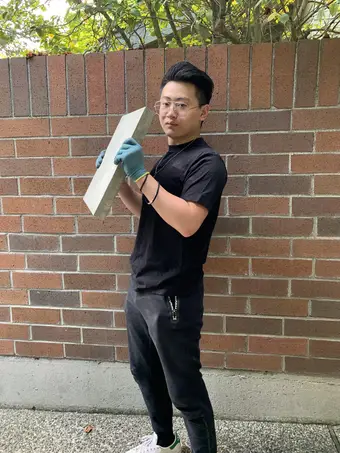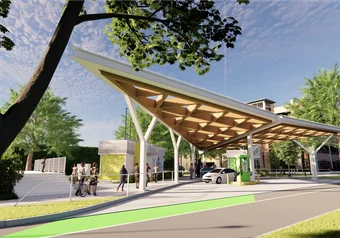Third-year chemical engineering student Zeyang (Kevin) Zhang is one of the first people in the world to work with graphene-enhanced concrete — a material with the potential to reduce carbon emissions and revolutionize the building industry.
Over the past three months, Zhang dedicated his time in a co-op with the start-up material company UberCrete. Most of his day is spent creating various graphene-concrete mixtures and assessing their properties through a variety of tests.
Harder, newer, greener, stronger
Unlike regular concrete, graphene-enhanced concrete has increased durability, saline resistance and water resistance. This makes it ideal for building along ocean coastlines which can normally wear away regular concrete in the long term, according to Zhang.
The inclusion of graphene can also reduce the amount of cement per required concrete material, meaning that this technology could significantly reduce carbon emissions from cement manufacturers, according to a 2018 study. As cement manufacturing is a leading source of global emissions — accounting for five per cent of the global “man-made” carbon dioxide emissions in 2012 — this technology could have wide implications for tackling the environmental impacts of this industry.
The increased water resistance of graphene-enhanced concrete would also make it an “even better” fit for Vancouver’s rainy climate than regular concrete, said Zhang in an emailed statement to The Ubyssey.
While the basic science behind graphene-enhanced concrete has already been developed, Zhang’s work at UberCrete aims to bridge the gap between scientific theory and commercial applications.
While some researchers only consider the traits of the hardened concrete such as compressive strength or water permeability, Zhang explained that his work also assesses the traits of the wet concrete mixture such as workability or viscosity (how much a substance resists flowing).
To assess viscosity, Zhang has conducted an experiment called the slump test. The test involves pouring the wet concrete mixture inside a mold called a slump cone. The mold is then removed, leaving the concrete in a cone shape which will naturally slump.
The distance from the top of the slumped concrete to the level of the top of the slump cone is then measured, providing information about the viscosity of the mixture. A less viscous concrete mixture is more workable, making it easier to be pumped up when constructing a high rise.
Cemented as an innovator
Zhang runs and coordinates tests with both academic and industry partners to ensure the graphene-enhanced concrete fits the requirements of Canadian and international building standards.
“I run the testing. I run the arranging logistics, I run the enhanc[ing] and improv[ing of] the formulas, I run the developing formulas and I run the making [of the actual concrete],” he said.
In one of his ventures, after experimenting with different ratios of cement and water, Zhang created a concrete mixture with a lustrous sheen. According to Zhang, this feature is notable as it saves time and money that would have been spent polishing the final concrete products.
As of now, only Zhang and another member of UberCrete know the specific ratios of water and cement needed for making the shiny concrete. He also stated that this discovery has garnered interest from investors.
Overcoming barriers
Looking back at all his accomplishments, Zhang recognized the challenges he has faced.
In an email, Zhang noted that he secured this job despite “COVID-19 as well as the rise [in] anti-Asian hate crime disturbing the employment opportunity for Asian Minorities.”
When asked if there were any specific barriers he overcame, he mentioned racist encounters in the community where he was called racial slurs. Zhang also mentioned the increased difficulty in finding a job as an international student due to citizen requirements.
Currently, Zhang is working on the side as UberCrete’s technical management officer, while finishing his schooling. In an emailed statement to The Ubyssey, Zhang said that after graduation he hopes to work at a chemical engineering plant or a chemical and materials manufacturing plant in a management position, with the goal of starting his own company one day.
“I aspire to change the chemical/material industry, and to help people and children with the money I make,” he wrote.
The article of part of The Ubyssey’s Sci Lit Week 2021 coverage. Keep an eye for more articles this week and check here for more!
First online
Share this article



![['auto']](https://storage.googleapis.com/ubyssey/media/renditions/3131274351_fc53aa1798_o_hr0Spqj.width-1000.format-webp.webp)
![['auto']](https://storage.googleapis.com/ubyssey/media/renditions/no.width-1000.format-webp.webp)
![['auto']](https://storage.googleapis.com/ubyssey/media/renditions/img_5382.width-1000.format-webp.webp)





